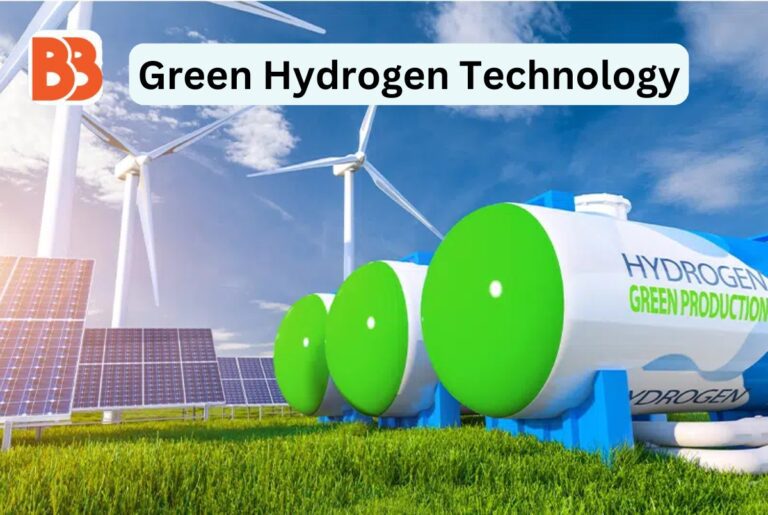While As the world shifts towards cleaner energy sources, green hydrogen technology is emerging as a promising solution to decarbonize various industries and revolutionize global energy systems. Unlike traditional hydrogen, which is derived from fossil fuels, green hydrogen is produced through electrolysis powered by renewable energy. This process splits water into hydrogen and oxygen, resulting in zero carbon emissions.
In this article, we’ll explore how green hydrogen technology works, its potential applications, challenges, and why it could be pivotal in achieving a carbon-neutral future.
How Green Hydrogen Technology Works
The production of green hydrogen involves a process called electrolysis, where an electric current passes through water (H2O), separating it into hydrogen (H2) and oxygen (O2). The key innovation here is using renewable energy sources, such as solar or wind power, to drive the process. As a result, green hydrogen is entirely free from greenhouse gas emissions, unlike its counterpart, grey hydrogen, which is produced using natural gas, releasing significant CO2.
The Importance of Green Hydrogen
Green hydrogen stands out as a crucial technology for the future for several reasons:
Decarbonization of Hard-to-Abate Sectors
While renewable energy sources like wind and solar can power homes and electric vehicles, certain industries—such as steel, cement, and heavy transportation—are harder to electrify. Green hydrogen provides a feasible, low-carbon alternative to fuel these industries.
Energy Storage
One of the major challenges with renewable energy is storage. The sun doesn’t always shine, and the wind doesn’t always blow. Green hydrogen can act as a form of energy storage by converting surplus electricity from renewables into hydrogen. This stored hydrogen can then be used later in fuel cells or other applications, effectively balancing energy grids.
Transportation Fuel
Hydrogen fuel cells offer a zero-emission solution for long-haul transport, aviation, and shipping, sectors that are challenging to electrify with batteries due to their high energy demands.
Applications of Green Hydrogen Technology
Green hydrogen has the potential to transform various industries and applications:
- Industries like steel and cement are major carbon emitters. Green hydrogen can be used as a substitute for coal and natural gas in industrial processes, significantly reducing emissions.
- Hydrogen fuel cell vehicles, especially for long-distance freight, buses, and ships, can become more viable as green hydrogen technology scales up.
- Green hydrogen can be stored and later used in fuel cells to provide electricity when renewable energy sources are not available, making it a key player in grid stability.
- Hydrogen can be burned in turbines to produce electricity, offering another avenue for decarbonizing power generation, especially when used in co-firing with natural gas.
Challenges Facing Green Hydrogen Technology
Despite its promise, green hydrogen faces several challenges:
High Costs
Producing green hydrogen via electrolysis is currently more expensive than conventional hydrogen production methods. However, as renewable energy becomes cheaper and electrolysis technology improves, the cost gap is expected to narrow.
Infrastructure Limitations
Hydrogen requires dedicated infrastructure for storage, transport, and distribution. Existing natural gas pipelines cannot simply be repurposed for hydrogen without major upgrades.
Energy Intensity
The process of electrolysis is energy-intensive. Large amounts of renewable energy are needed to produce sufficient quantities of hydrogen. Which could put pressure on the availability of clean energy sources.
Scale and Efficiency
Scaling green hydrogen production to meet global energy demands remains a challenge. Moreover, electrolysis has an efficiency rate of around 70–80%, meaning some energy is lost during the process.
The Global Push for Green Hydrogen
Countries around the world are recognizing the potential of green hydrogen in addressing climate change. Nations like Germany, Japan, and South Korea have already rolled out ambitious hydrogen strategies. With billions of dollars in investments aimed at developing infrastructure, research, and scaling production.
- Germany has set a target of 5 gigawatts of hydrogen capacity by 2030, with plans to become a global leader in green hydrogen production.
- Japan, a pioneer in hydrogen technology, aims to establish a hydrogen-based society by promoting its use in transport, industry, and energy storage.
- South Korea has announced a hydrogen roadmap to replace its coal-fired power plants with hydrogen plants by 2050.
The Future of Green Hydrogen Technology
The momentum behind green hydrogen is growing, and it has the potential to play a crucial role in achieving global net-zero emissions by mid-century. While challenges exist, ongoing research and government support are likely to reduce costs and develop the necessary infrastructure.
The future of green hydrogen will depend on technological advancements, policy frameworks, and investment in renewable energy. You can also learn about “Dark Web Marketplaces: How They Function and Why They Persist“. As costs come down and infrastructure is built, green hydrogen could become a vital pillar in the global clean energy transition, complementing solar, wind, and other renewables.
Conclusion
Green hydrogen technology offers a promising path toward decarbonizing energy-intensive sectors, providing a solution for industries where direct electrification is difficult. It represents an essential component in the quest for a sustainable, carbon-neutral future. As countries ramp up their hydrogen strategies and investments in renewables increase. Green hydrogen could soon shift from being a niche technology to a cornerstone of the global energy system.
With the potential to revolutionize energy storage, industrial processes, and transportation, green hydrogen is undoubtedly a critical player in the fight against climate change. While challenges remain, the coming years will likely see significant advancements in green hydrogen technology. Bringing us one step closer to a cleaner and more sustainable energy future.
